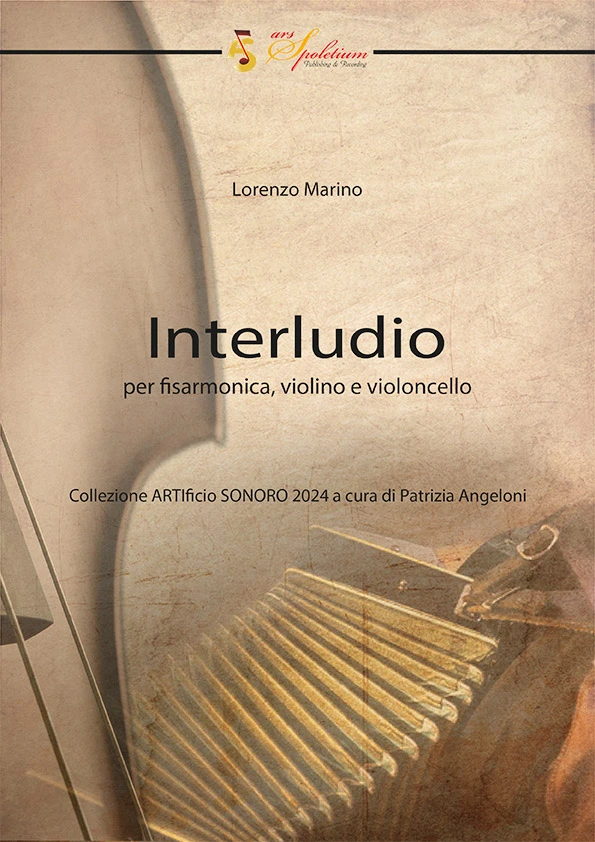Interludio – per fisarmonica, violino e violoncello
Composition produced in the framework of the Erasmus+ Programme-Action KA1 – Scope VET Project n° 2023
1-IT01-KA122-VET-000148608-OID-E10282245
Mobility for the Growth of Skills in the Music Sector.
Interludio è un termine che designa – in ambito musicale – un momento di passaggio, spesso strumentale, collocato tra sezioni più strutturate o narrative di un componimento su più larga scala. In questo contesto, Interludio si presenta come una parentesi raccolta e quasi confidenziale nata dalla spontaneità del dialogo cameristico tra fisarmonica, violino e violoncello e come germe potenziale di un più ampio progetto.
(LA PARTITURA IN OGGETTO È DISPONIBILE SOLO NELLA VERSIONE PDF)
Interludio is a term used in music to denote a transitional passage – often instrumental – inserted between more structured or narrative sections of a larger-scale composition. In this context, Interludio presents itself as a quiet, almost confidential moment, born from the spontaneity of the chamber interplay between accordion, violin, and cello, and as the potential seed of a broader project.
(ONLY PDF VERSION)
Composition produced in the framework of the Erasmus+ Programme-Action KA1 – Scope VET Project n° 2023
1-IT01-KA122-VET-000148608-OID-E10282245
Mobility for the Growth of Skills in the Music Sector.
Interludio è un termine che designa – in ambito musicale – un momento di passaggio, spesso strumentale, collocato tra sezioni più strutturate o narrative di un componimento su più larga scala. In questo contesto, Interludio si presenta come una parentesi raccolta e quasi confidenziale nata dalla spontaneità del dialogo cameristico tra fisarmonica, violino e violoncello e come germe potenziale di un più ampio progetto. Scritto nel 2024 in stretta collaborazione con Riccardo Pugliese e il Trio Zazel (ai quali è dedicato), il brano si sviluppa come una fitta ma discorsiva intelaiatura tra le componenti strumentali, che ricercano una simbiosi timbrica tanto nell’arco dello sviluppo macro-formale quanto nelle sue soluzioni più puntuali. L’arcata strutturale complessiva riflette un gioco di riletture e trasformazioni che partendo da un’iniziale distanza simbolica — caratterizzata da una scrittura da temp lisse nel suo sviluppo — approda improvvisamente a una dimensione più concreta e materica del suono. Un’immaginaria linea, quindi, di (dis)continuità conduce alla rottura dell’equilibrio dello strumento-trio e all’emersione della voce del violoncello, la cui cadenza – configurandosi come un punto di non ritorno nel più ampio contesto della struttura macro-formale – sancisce l’esaurimento dell’energia propulsiva e conduce, nonostante il reintegro
della complicità cameristica, verso una malinconica sezione conclusiva che liquida gradualmente le varie e condivise gestualità strumentali. Pensato come progetto in espansione, Interludio agirebbe al suo interno come un nucleo centrale di un ciclo per grande ensemble, cuore silenzioso capace di informare di sé l’intero disegno.
Interludio is a term used in music to denote a transitional passage – often instrumental – inserted between more structured or narrative sections of a larger-scale composition. In this context, Interludio presents itself as a quiet, almost confidential moment, born from the spontaneity of the chamber interplay between accordion, violin, and cello, and as the potential seed of a broader project. Composed in 2024 in close collaboration with Riccardo Pugliese and the Trio Zazel (to whom the piece is dedicated), the work unfolds as a dense yet discursive interweaving of instrumental parts, seeking a timbral symbiosis both across the macroformal arc and in its more detailed articulations. The overall structure reflects a process of continuous reinterpretation and transformation: beginning with a symbolic distance—characterized by a temps lisse approach to temporal development—it suddenly transitions toward a more tangible, material conception of sound. An imaginary (dis)continuous line gradually leads to the disruption of the trio-as-instrument equilibrium and to the emergence of the cello’s voice, whose solo cadenza marks a point of non-return within the formal architecture. This moment signals the exhaustion of the initial propulsive energy and, despite the return of the chamber-like complicity, ushers in a melancholic closing section that gradually dissolves the shared instrumental gestures. Conceived as part of an expanding project, Interludio would serve as the central core of a larger cycle for large ensemble – a silent heart, capable of informing the entire design from within.




